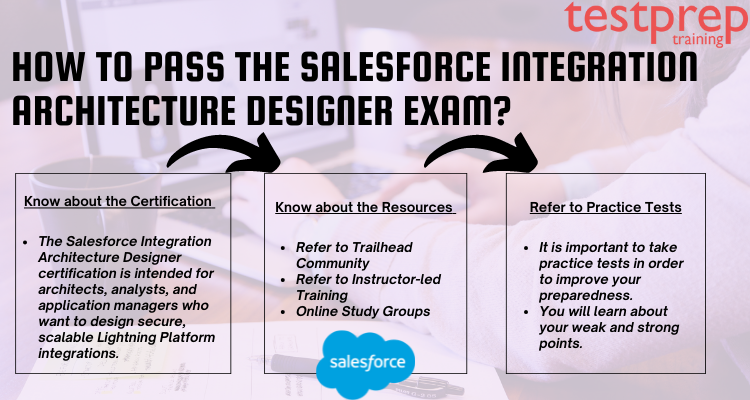The Salesforce Integration Architecture Designer Exam is a certification exam that validates the knowledge and skills of professionals who design and implement integration architectures between Salesforce and other systems. The exam tests a candidate’s ability to develop and implement complex integration solutions using various integration tools and techniques provided by the Salesforce platform.
The Salesforce Integration Architecture Designer certification exam is designed for experienced integration architects, developers, and solution designers who work with the Salesforce platform and related technologies. Candidates for this exam should have a deep understanding of Salesforce data and security models, as well as experience with integrating Salesforce with other applications using APIs, middleware, and other tools. The exam requires a solid understanding of enterprise integration patterns, data mapping and transformation, and system design and architecture principles.
Salesforce Integration Architecture Designer Exam Glossary
Here are some general terms related to Salesforce integration that might be relevant:
- API: Stands for Application Programming Interface, a set of protocols and tools for building software applications.
- Integration: The process of connecting two or more separate systems or applications, allowing them to share data and work together seamlessly.
- Middleware: Software that acts as a bridge between two or more systems or applications, enabling them to communicate and exchange data.
- ETL: Stands for Extract, Transform, Load, a process used for moving data from one system to another, typically involving data extraction, data transformation, and data loading.
- Data mapping: The process of defining how data from one system maps to data in another system, enabling them to exchange data seamlessly.
- SOAP: Stands for Simple Object Access Protocol, a messaging protocol used for exchanging structured data between systems over the internet.
- REST: Stands for Representational State Transfer, a style of web architecture that uses HTTP requests to communicate between systems.
- OAuth: An open standard for authorization that allows third-party applications to access a user’s data without requiring the user to disclose their login credentials.
- Web services: A software system designed to support interoperable machine-to-machine interaction over a network.
- Integration patterns: Reusable solutions to common integration problems, such as data transformation, routing, and aggregation.
Salesforce Integration Architecture Designer Exam Guide
Here are some official resources for the Salesforce Integration Architecture Designer Exam:
- Salesforce Certification website: https://trailhead.salesforce.com/credentials/integrationarchitecture
- Exam Guide: The exam guide provides an overview of the exam, including the exam format, topics covered, and sample questions. You can find the exam guide on the Salesforce Certification website.
- Trailhead: Trailhead provides free online courses and modules to help you prepare for the exam. The Integration Architecture Designer module covers the topics you need to know for the exam. You can find it on the Trailhead website: https://trailhead.salesforce.com/content/learn/modules/integration-architecture-designer
- Instructor-led training: Salesforce offers instructor-led training for the Integration Architecture Designer Exam. You can find more information about the training on the Salesforce Certification website.
- Official practice exam: The official Salesforce practice exam is designed to help you prepare for the actual exam. You can purchase it on the Salesforce Certification website.
- Community: The Salesforce community is a great resource for getting tips and advice from others who have taken the exam. You can join the community on the Salesforce website: https://trailblazers.salesforce.com/_ui/core/chatter/groups/GroupProfilePage?g=0F93A000000LqCp
- Documentation: The Salesforce documentation provides detailed information about the features and capabilities covered in the exam. You can find the documentation on the Salesforce website: https://help.salesforce.com/home
Salesforce Integration Architecture Designer Exam Tips and Tricks
Here are some tips and tricks to prepare for the Salesforce Integration Architecture Designer exam:
- Understand the exam format: The Salesforce Integration Architecture Designer exam consists of 60 multiple-choice questions, and you have 105 minutes to complete the exam. It is a proctored exam that can be taken remotely or at a testing center.
- Review the exam guide: The Salesforce Integration Architecture Designer exam guide provides an overview of the exam, including the topics covered and the weighting of each section. Make sure you review this guide thoroughly before starting your preparation.
- Study the exam topics: The Salesforce Integration Architecture Designer exam covers a range of topics, including integration architecture, data modeling, data integration, API integration, security, and performance. Study each topic in detail and make sure you have a good understanding of the concepts.
- Use official resources: Salesforce provides a range of official resources to help you prepare for the exam, including Trailhead modules, study guides, and sample questions. Make sure you use these resources as they are designed to help you succeed on the exam.
- Take practice exams: Practice exams are a great way to familiarize yourself with the exam format and test your knowledge. Salesforce provides a range of practice exams that can help you prepare for the Integration Architecture Designer exam.
- Join a study group: Joining a study group can be a great way to share knowledge and learn from others. Salesforce has a community of certified professionals who are always willing to help and share their experiences.
- Hands-on experience: It is important to have hands-on experience with Salesforce Integration Architecture Designer concepts. Try to work on different projects or real-world scenarios to get a better understanding of the concepts and their practical application.
- Time management: Time management is crucial during the exam. Make sure you read each question carefully and understand what is being asked before answering. If you get stuck on a question, move on to the next one and come back later.
- Stay calm and confident: Finally, stay calm and confident during the exam. Take deep breaths, read each question carefully, and trust in your preparation. Remember, you got this!
How to pass the Salesforce Integration Architecture Designer Exam?
The certification exam is intended to assess a candidate’s ability to communicate technical solutions to technical stakeholders while also providing a project delivery framework that ensures quality and success. Let us look at steps that will help you in passing this exam –

Step 1 – Learn about the exam objectives
These are the objectives of this exam –
Evaluate the Current System Landscape: 8%
- Given a set of business requirements, identify the current system landscape and determine what standards, limitations, boundaries, and protocols exist.
- Moreover, Given an existing system landscape, analyze for constraints and/or pain points to satisfy a business requirement(s).
- Given a set of requirements, evaluate the authentication and authorization needs to be based on the system landscape.
Evaluate Business Needs: 11%
- Given a use case, identify functional and non-functional requirements needed for integration.
- Based on a given integration requirement, identify and classify data into Confidential/Secure/Public.
- Moreover, Given a use case, identify key factors for CRM success that should be included as integration requirements.
- Given a use case, identify the business growth and regulatory factors that can impact the choice of integration solutions.
Translate Needs to Integration Requirements: 22%
- Given an existing system landscape diagram, create an inventory of the systems and integration patterns.
- Moreover, Given a use case and business process, evaluate system and process constraints.
- Given a use case, identify integration security / authentication / authorization requirements.
- Furthermore, Given a use case, identify performance needs (volumes, response times, latency) and propose appropriate integration solutions that will meet business requirements.
Design Integration Solutions: 28%
- Firstly, Given a use case, identify the integration pattern that meets business requirements.
- Given a use case, define the components which create a solution that meets business requirements.
- Moreover, Given a use case, identify the trade-offs, limitations, and constraints that meet the proposed solution.
- Given a use case that includes technical requirements, constraints or drivers, specify the appropriate Salesforce API(s) for the proposed solution.
- Furthermore, Given a use case that includes technical requirements, constraints or drivers determine the standards, components, techniques, and security mechanism that should be used.
Build Solution: 23%
- Given a use case that includes technical requirements, constraints or drivers, identify the considerations when designing and implementing API(s), both Salesforce as an API provider and Salesforce as an API consumer.
- Given a use case, identify the considerations when choosing the right option in making an outbound call to an external system.
- Furthermore, Given a use case, describe what should be considered when building a scalable solution.
- Given a use case, determine error handling for different integration options.
- Additionally, Given a use case, create a security solution for inbound or outbound integrations.
- Finally, Given a use case, identify the factors needed to build resilience in an integration solution for system updates.
Maintain Integration: 8%
- Given an integration maintenance use case, identify performance monitoring needs for integration requirements.
- Furthermore, Given a use case, identify the appropriate error handling, escalation and recovery procedures for a failed integration.
- Finally, Given a use case, identify reporting needs for integration monitoring.
Step 2 – Refer Recommended Training and References
Hands-on experience, training course completion, Trailhead trails, and self-study in the areas listed in the Exam Outline section of this exam guide are all recommended. The following self-study materials are recommended for this exam:
Architect Journey: Integration Architecture Trailmix
To enroll in expert-led courses, open your Salesforce application, click the Help & Training link in the upper right corner of the screen (login required), and search for the courses you want. Non-Salesforce customers can sign up for expert-led courses on this page.
Search for the topics listed in the Exam Outline section of this guide and study the information related to those topics in online Documentation, Tip Sheets, and User Guides. Help & Training also provides access to documentation, tip sheets, and user guides.
Step 3 – Refer Additional Resources
Study groups – The candidate must acquire and share knowledge in order to pass the Salesforce Marketing Cloud Administrator exam. As a result, we recommend that you participate in a study where you can discuss the concepts with others who share your goal. This will guide the candidate throughout the preparation process.
Practice Tests – The most important step is to take the practice test. Salesforce Integration Architecture Designer Practice Exams provide candidates with confidence in their preparation. Nowadays, there are numerous practice tests available on the internet; the candidate can select whichever one they prefer. The Salesforce Marketing Cloud Administrator practice test is extremely helpful in preparing for the exam. So, begin preparing right away!

Step 4 – Take the Exam
You are now ready to take the exam after practicing and consulting appropriate resources. Remember to stay calm and patient while taking the exam. When it comes to exam preparation, the value of time management cannot be overstated. As a result, we recommend that you regularly study Salesforce Integration Architecture Designer Exam. You should ideally study at the same time every day. When studying, make sure there are no distractions.
Step 5 – Maintaining your Credential
One of the advantages of having a Salesforce credential is that you are always up to date on new product releases (updates). As a result, you must complete the Integration Architecture Designer certification maintenance modules on Trailhead once a year. Don’t let your hard-earned qualification expire! Your credential will expire if you do not complete all maintenance requirements by the due date.
Final Words
This exam will put your knowledge to the test in a realistic setting. Because it contains so much terminology, most test-takers memorize it in order to pass the exam. Furthermore, regular reading will help you understand topics and apply what you’ve learned in real-life situations. Hurry up and start practicing now!



